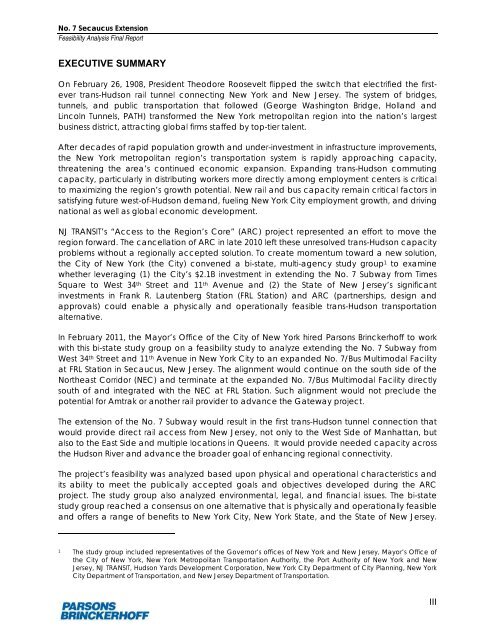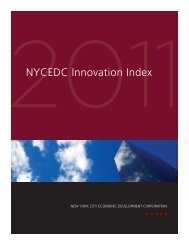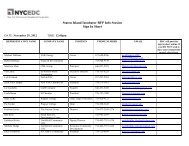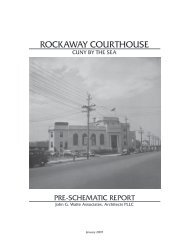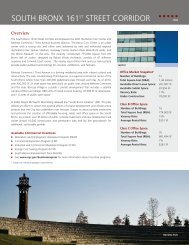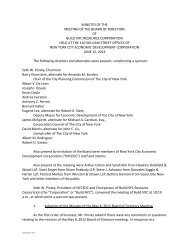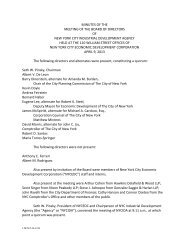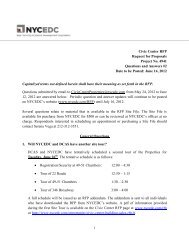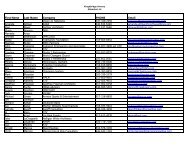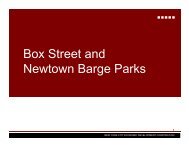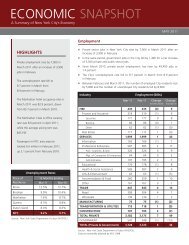No 7 Secaucus Extension Final Report - NYCEDC
No 7 Secaucus Extension Final Report - NYCEDC
No 7 Secaucus Extension Final Report - NYCEDC
You also want an ePaper? Increase the reach of your titles
YUMPU automatically turns print PDFs into web optimized ePapers that Google loves.
<strong>No</strong>. 7 <strong>Secaucus</strong> <strong>Extension</strong>Feasibility Analysis <strong>Final</strong> <strong>Report</strong>EXECUTIVE SUMMARYOn February 26, 1908, President Theodore Roosevelt flipped the switch that electrified the firstevertrans-Hudson rail tunnel connecting New York and New Jersey. The system of bridges,tunnels, and public transportation that followed (George Washington Bridge, Holland andLincoln Tunnels, PATH) transformed the New York metropolitan region into the nation’s largestbusiness district, attracting global firms staffed by top-tier talent.After decades of rapid population growth and under-investment in infrastructure improvements,the New York metropolitan region’s transportation system is rapidly approaching capacity,threatening the area’s continued economic expansion. Expanding trans-Hudson commutingcapacity, particularly in distributing workers more directly among employment centers is criticalto maximizing the region’s growth potential. New rail and bus capacity remain critical factors insatisfying future west-of-Hudson demand, fueling New York City employment growth, and drivingnational as well as global economic development.NJ TRANSIT’s “Access to the Region’s Core” (ARC) project represented an effort to move theregion forward. The cancellation of ARC in late 2010 left these unresolved trans-Hudson capacityproblems without a regionally accepted solution. To create momentum toward a new solution,the City of New York (the City) convened a bi-state, multi-agency study group 1 to examinewhether leveraging (1) the City’s $2.1B investment in extending the <strong>No</strong>. 7 Subway from TimesSquare to West 34 th Street and 11 th Avenue and (2) the State of New Jersey’s significantinvestments in Frank R. Lautenberg Station (FRL Station) and ARC (partnerships, design andapprovals) could enable a physically and operationally feasible trans-Hudson transportationalternative.In February 2011, the Mayor’s Office of the City of New York hired Parsons Brinckerhoff to workwith this bi-state study group on a feasibility study to analyze extending the <strong>No</strong>. 7 Subway fromWest 34 th Street and 11 th Avenue in New York City to an expanded <strong>No</strong>. 7/Bus Multimodal Facilityat FRL Station in <strong>Secaucus</strong>, New Jersey. The alignment would continue on the south side of the<strong>No</strong>rtheast Corridor (NEC) and terminate at the expanded <strong>No</strong>. 7/Bus Multimodal Facility directlysouth of and integrated with the NEC at FRL Station. Such alignment would not preclude thepotential for Amtrak or another rail provider to advance the Gateway project.The extension of the <strong>No</strong>. 7 Subway would result in the first trans-Hudson tunnel connection thatwould provide direct rail access from New Jersey, not only to the West Side of Manhattan, butalso to the East Side and multiple locations in Queens. It would provide needed capacity acrossthe Hudson River and advance the broader goal of enhancing regional connectivity.The project’s feasibility was analyzed based upon physical and operational characteristics andits ability to meet the publically accepted goals and objectives developed during the ARCproject. The study group also analyzed environmental, legal, and financial issues. The bi-statestudy group reached a consensus on one alternative that is physically and operationally feasibleand offers a range of benefits to New York City, New York State, and the State of New Jersey.1 The study group included representatives of the Governor’s offices of New York and New Jersey, Mayor’s Office ofthe City of New York, New York Metropolitan Transportation Authority, the Port Authority of New York and NewJersey, NJ TRANSIT, Hudson Yards Development Corporation, New York City Department of City Planning, New YorkCity Department of Transportation, and New Jersey Department of Transportation.III


